Happiness has been debated, researched and theorised upon by theologians, psychologists, philosophers and even physiologists all opining on, why and how; many offering guaranteed techniques to achieve this much sought after and illusive emotional state. It may seem a daunting task to deliver all one needs to know about happiness but we will try.
A good place to begin is to agree a definition for happiness and that is where the debate begins. Emotions and contentment are difficult to quantify and always a personal judgment. Happiness is normally defined as, “a state of well-being, typically accompanied by pleasant emotions, which may run the gamut from contentment to joy.” If one is asked, “Are you happy?”
It is well-accepted in academic circles, that if the answer is negative, then most certainly, the respondent is not happy. Importantly, because the state or emotional status of happiness is self-defined, there exists the phenomenon which demonstrates that a large part of the population will respond that they are happy, when in fact they are not. They may say, “I am fine,” or “I am great,” because they believe that just being positive will produce happiness. Positivity, while preferable to negativity, is often short-lived and seldom a prescription for achieving sustainable happiness.
The internationally acclaimed football/soccer coach, Jose Mourinho who became a media star when he described himself upon his 2005 arrival in London as a “special one,” returned in 2013 to the team of his early success, Chelsea, and changed his auto-description to the “happy one.” When asked, why he was “happy” he answered, because he had returned to London, which he and his family enjoyed, and also because he looked forward to the “interesting challenge” of winning trophies for the fans who sing his name.
It is noteworthy to mention that Mourinho, who many believe may be viewed as the greatest Coach ever, considers family, success, challenges and acclamation as key ingredients to his happiness. It is illustrative that only two years after his “happy one,” denomination he had won two more trophies and subsequently “crashed and burned,” fighting with employees, players, the league administrators who fined and sanctioned him, referees and ultimately his employers. While pundits and psychologists opine on the Chelsea Coach’s loss of leadership and “evident unhappiness” the media enjoys covering the difficulties of someone who dared to acclaim his personal happiness and revels in reporting his fall from contentment.
When we bravely state we are “happy,” we many times fear it is only momentary and the mere recognition of one’s emotional summit may begin the fall and decline into despair and unhappiness. The theory that too much good is bad, is a logical conclusion, drawn from the duality in the human condition, which pre-disposes us to believe we will experience emotional peaks and valleys. Many people prefer not to feel content because striving forward emotionally, is better than falling backward. They chose NOT to say they are happy. Indeed, they decide to NOT be happy.
Whitespace says the basic question, which each of us must answer in our individualised way is, “Do we think we can be happy?” If we don’t believe we deserve happiness, then it is unachievable no matter what techniques one employs. The other undeniable requirement to reach contentment is the realisation that happiness is not caused by external forces but by taking personal responsibility for our emotional state.
Whitespace clients are challenged to be self-aware and pursue happiness, not be content with mediocrity or fixated on what our founder Karren Brooks calls the “myth of multiplicity.” Karren says our modern media driven society convinces us that to attain happiness we need, “multiple homes and multiple lovers and multiple orgasms” while what we really need is “the presence to enjoy that, which we do have.”
Noted psychologist Martin Seligman attempted to quantify and qualify the external factors which lead to happiness and concluded that while important, the external influences on one’s happiness are less important than one’s personal attitude. Seligman developed five important factors to measure when it comes to contentment and used the acronym, P.E.R.M.A.
- Pleasure (sensual enjoyment of taste, touch, sounds etc.)
- Engagement (flow or energy exchanged in a challenging activity.)
- Relationships (social bonds are important indicators of happiness.)
- Meaning (the feeling derived from an important challenge.)
- Accomplishments (achieving the satisfaction of goal attainment.)
While the P.E.R.M.A. factors are a comprehensive list, Seligman stressed that our response to these external influences could vary. Whitespace methodology emphasizes the importance of Presence or that state of self awareness, which allows one to recognise our emotional response to the PERMA factors and allows us to enjoy the good things rather than worrying about past and future events that might not be as pleasant. Karren Brooks says, “all to often we are caught up in the past and listen to our inner voice saying, ‘should have, or would have or could have,’ rather than celebrating our wins.”
Happiness has become topical and has even reached the “Red Tops” in London as reported in this excerpt from the Daily Mail. ‘You can choose to live focusing on what is right and beautiful in your life,’ said Dr Amit Sood, the author of a new book, ‘The Mayo Clinic Handbook for Happiness: A Four-Step Plan for Resilient Living.
‘Happiness is a habit,’ he declares, ‘Some of us are born with it; others have to choose it.’ Read more in the Daily Mail article.







